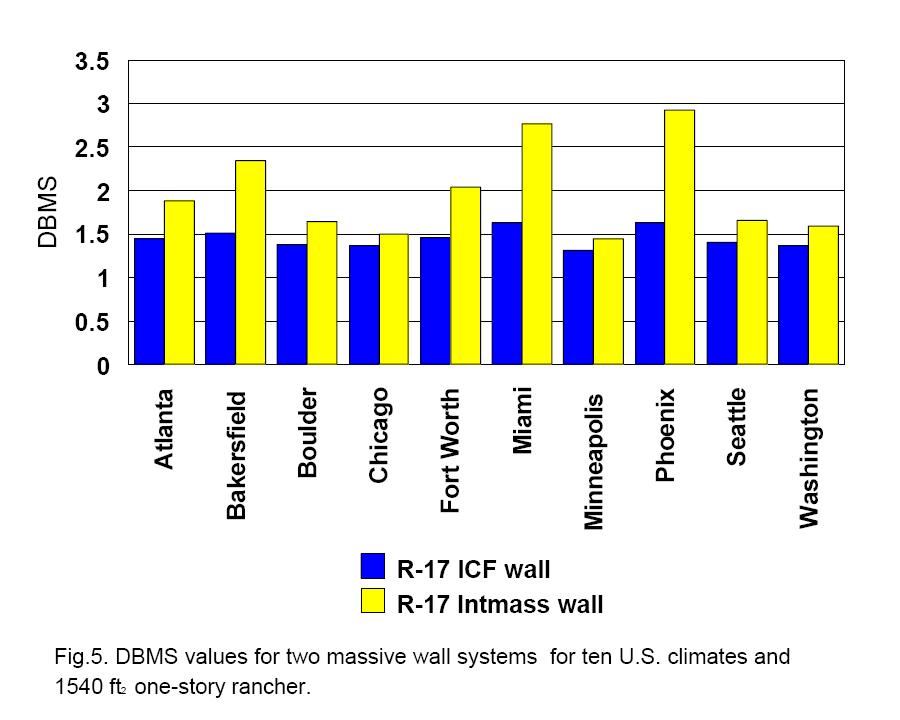
Search
The Renewable Energy site for Do-It-Yourselfers
Effective R Value
of ICF Wall
|
Insulated Concrete Form (ICF)
construction is becoming quite popular. The main reasons being the
combination of structural integrity, high R value, relatively easy
construction, and high thermal mass that ICF's provide.
The reasons for the good
thermal efficiency of ICF's are: 1) minimal thermal bridging (that is no
wall studs to short circuit the insulation), 2) the polystyrene forms
provide a pretty good R value, 3) the high thermal mass of the wall
results in an increase in effective R value.
There has been some debate
about the actual effective R value of ICF walls. The R value of a
typical ICF wall calculated in the traditional way (i.e. summing up the
r value of each component) is not exceptional (typically about R16), but
the claim made by ICF supporters is that the high thermal mass of the
wall results in a higher effective R value. The ORNL (Oak Ridge
National Labs) did a careful
simulation analysis of various ICF configurations to try to
determine the actual benefit of the thermal mass in the ICF wall.
|
|
To me, the figure below sums up the
results of the study.
The figure was developed using a
simulations of a typical 1500 sqft ranch style home with the usual stick
construction with two types of insulated concrete form walls. The figure
shows that a typical ICF wall has an R value about 1.5 times greater than what
you would expect from summing up the R values of its components. That is,
the thermal mass increases the effective R value of the wall by about 50%.
The improvement due to thermal mass ranges from about 40% up to about 70%
depending on the climate where the house is located. Warm climates appear
to benefit somewhat more than cold climates. For example, if the nominal R value
of a typical ICF wall is R16. The graph says that if you are building the
home in Boulder, CO, it would perform comparably to a stick construction home
with 1.4 times this R value -- i.e. the stick construction home wall would have
to be R 22 to have the same heat loss. To me, this is particularly
significant in that stick built walls tend to perform below their nominal R
values.
Two types of walls are shown in the
figure. The blue bars represent walls with typical ICF construction --
that is forms made of polystyrene with hollow cores filled with concrete.
The yellow bars show a wall construction with insulation on the exterior, and
the concrete mass on the interior -- for example a concrete block wall with
exterior foam board insulation.
The bottom line (to me) is:
-
Conventional ICF walls have an
effective R value of 1.4 to 1.7 times that of an equivalent insulation stick
wall depending on climate.
(But, note update at bottom of this page)
-
Concrete or block walls with the
insulation on the exterior perform better than the usual ICF construction --
the difference effective R value in some climates can be nearly twice that
of ICF construction, but in most climates its more like a 20% gain.
The improvement for exposed thermal mass walls on passive solar homes might
be even more?
I have heard and seen claims for ICF
R values that go well beyond what the
ORNL study supports, so be careful.
Overall, ICF's look like a pretty
good choice to me, and might be well suited to owner built homes -- see the
links in this section 1) "A Fast
Foundation", Fine Homebuilding magazine, and 2) "One
Year in A Foam House".

Figure from the
ORNL report on ICFs
Update:
A recent study of and ICF building
set out to measure actual R values, and see how much of a role the concrete
thermal mass played in the thermal performance of the building. It appears
that at least in this case, the thermal resistance of the wall can pretty much
be explained by just the R value of the insulating form, and that the concrete
did not add substantially to the performance of the building.
The full ICF R value paper...
Gary Nov 27, 2007, May 21, 2008

